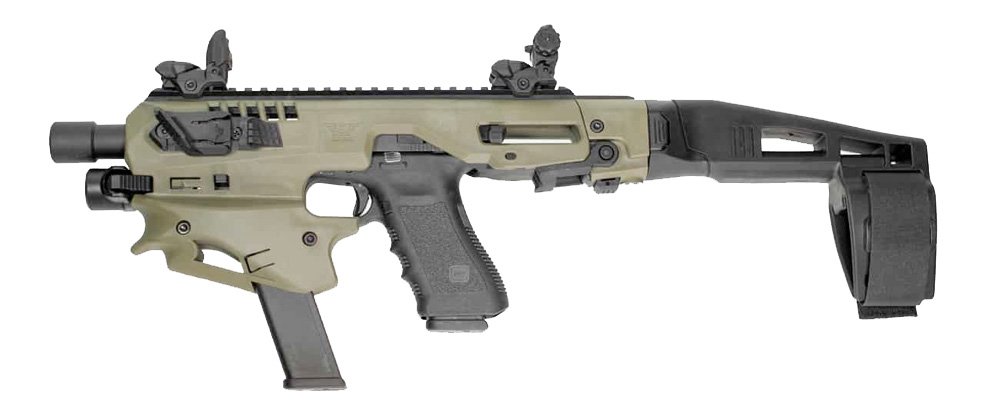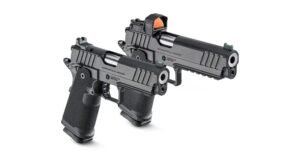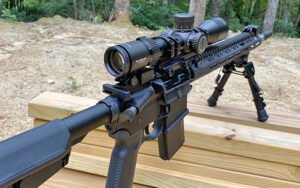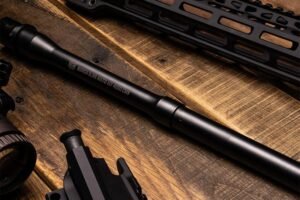CAA Micro RONI MCK Review – Great or Gimmick?
CAA Micro RONI MCK Review
Did someone say “Macaroni”? You’d be forgiven if you haven’t given stabilizers like the RONI MCK (Micro Conversion Kit) much thought. But with a bit of help, I’ve come around. Here’s DC Tactical’s CAA Micro RONI Review.

What’s a Micro Roni?
If you aren’t familiar with the concept, the Micro RONI from Command Arms Accessories (CAA) is a “drop-in” conversion accessory that allows a variety of standard semi-automatic handguns to shoot more like a Personal Defense Weapon (PDW) carbine. This conversion is achievable within seconds and requires zero modification to your handgun to work. Slide your pistol into the housing, active the locking mechanism, and start shooting. There are now three variations available for compatibility with a variety of Glock, SIG, and Smith & Wesson M&P 2.0 handgun models respectively.
“Okay, so your standard sidearm is now a bit bigger now and looks like a space gun. Great.” Maybe, like me, you were quick to dismiss these “stabilizers” as nothing more than novelty items – something Glock (and now a few other popular manufacturer) owners could spend their money on to make themselves feel special. Don’t get me wrong, I definitely think pistol caliber carbines have a place in the world and can be great defense firearms, but my logic being that a dedicated pistol caliber AR or similar platform would surely be superior, right?
Based on that reasoning, I’ve admittedly turned my nose up at these and similar pistol conversion “accessories” without giving them a second thought. It wasn’t until spending some time at CAA’s booth at this year’s SHOT Show that I really started to see the potential of a Micro RONI system across several real-life applications.
Why a Micro RONI System Might be for You
While the average handgun cartridge may technically be effective out to 100 yards or more, shooting accurately at those distances with a standard handgun model is well outside the capabilities of only the most highly trained shooters. Clearly, that’s not their intended use. This puts anyone at a disadvantage when needing to engage at those distances.
To be clear, the RONI doesn’t modify the donor firearm in any way. It doesn’t extend the barrel, or make it do anything from a functionality standpoint that it can’t already inherently do on it’s own. What it does do is fundamentally transform how the shooter wields their firearm, helping them to maximize the performance of the donor handgun. Going one step further, this configuration also helps allow for extended magazines or other additional accessories that quickly make a standard handgun very cumbersome.
Okay, so it can help you get performance out of your handgun that you wouldn’t normally be achievable. Why is that a big deal?
Well, it’s a big deal if a handgun is all the firepower you might normally want to have, yet could imagine scenarios where you wish you had more. With the addition of a stock or brace and two-handed operation, the Micro RONI stabilizer can give an instant boost to handling and accuracy to your standard sidearm.
Real Life Applications for the Micro RONI
CAA positions the Micro RONI as not only the fastest assembly/disassembly of any stabilizer accessory on the market, but also the most cost effective. At the time of this writing the Gen 4 version retails at most places for around $250. Not bad for a quality piece of US-made gear (previous versions were manufactured in Israel). When you compare that to the cost of a decent quality pistol caliber carbines, the Micro RONI becomes that much more attractive. If you’re already an owner of a compatible handgun, that’s not a big investment to get a lot more out of that handgun. Keep in mind that when you boil it right down to ballistic performance, a standalone 9mm carbine with a 5″ barrel isn’t doing anything that a Glock G17 can’t do as well.
However, throw an optic-equipped RONI and a couple of extended magazines into a sling pack, and your daily carry pistol can very quickly become a high-capacity PDW-like carbine that’s far more capable in any number of tactical situations. Longer-distance, rapid fire shooting becomes much more manageable with a two-handed grip and brace.
From a tactical accessory standpoint, the RONI has all your bases covered. It features a flashlight mount, and a QD point to attach a single point sling. It even has an easily accessible storage well for a second magazine so you have one less thing to carry. There is a continuous picatinny rail along the top for sights and optics, as well as smaller picatinny rails along the each side for lights or lasers. CAA also offers specialized thumb rests to attach to these side rails which help to further stabilize the shooters grip on the unit.
A standard sidearm might be more than adequate for most day-to-day defense scenarios, but one can certainly imagine scenarios where a handgun might be outgunned. With a RONI close by, along with an additional high-capacity magazine or two, suddenly that scenario isn’t so one-sided. As you can imagine, this type of flexibility becomes a great asset for anyone tasked with protection or security. Again, all with zero modification to the donor firearm.
Firepower…Not Firearm
Of course, this all circles back around to a big benefit of the Micro RONI: it’s not a firearm. Until it’s mated with a compatible handgun, the RONI is completely inert. That can give a lot of peace of mind to anyone who might be hesitant, or simply find it impractical, to store a PDW-style firearm in certain places. If the RONI is ever stolen, the implications are far less dire than if thieves were to get their hands on an actual gun.
The RONI’s folding stock/brace takes up minimum space. It’s easy to store inconspicuously, but quick to deploy when needed. A school resource officer could keep a Micro RONI system in a locked desk drawer, ready for a worst-case scenario. Handgun-armed security personnel could keep one in a sling pack with no one giving a second thought. The average civilian could store the Roni as part of their vehicle’s emergency kit, ready to pair with their everyday carry sidearm if the need arises.
The practical applications are endless, and all without the additional concerns that surround the proper and safe storage of a traditional firearm.

Lots of Options
The Gen 4 Micro RONI is currently available (or available for pre-order) in four models, compatible with the following handguns:
- Standard and compact frame Glocks ( G17/G19/G19X/G22/G23/G31/G32/G45) in 9mm, .40 S&W and .357 Sig
- Standard frame Glocks (G20/G21) in 10mm and .45 ACP
- SIG Sauer P320 in 9mm and .40 S&W
- Smith and Wesson M&P 2.0 in 9mm and .40 S&W
Each model is available with either or collapsible brace or stock. Keep in mind, that mating your pistol to a stock version would require a tax stamp as it would be considered a short barreled rifle. The brace version is non-NFA, and likely the version most civilians would opt for. The length of pull on both stock and brace are equal, and having handled both, I feel that the stock version doesn’t do anything better than the brace.
But wait! There’s more! The RONI MCK is also available in four colors: Black, OD Green, FDE and White.
Summary
To sum it up nicely, a Micro RONI system can be stored without the same concerns as a live firearm, yet very quickly boost the capabilities of a compatible handgun to give you the benefits of a PDW carbine – all at a very reasonable cost. As an added bonus, because it’s not a firearm, it can be shipped to your door…no FFL transfer required.
Springfield Armory Prodigy Review
The Springfield Armory Prodigy takes the proven 1911 platform and enhances it with double-stack capacity and a performance-driven feature set.
What is a RECCE Rifle? Meet the Longshot
US Navy Seals developed today’s Recce Rifle concept in the early 90s to bridge the tactical gap between their CQB M4s, and their larger and heavier precision rifles.
Smith & Wesson CSX Review
Smith & Wesson’s CSX joins the market of similar high capacity micro 9s while standing out from the crowd with features and flourishes not found on many competitors.
5.56 NATO VS .223 WYLDE
People new to the AR-15 can be forgiven for believing that they’re only made to fire the 5.56 NATO cartridge – the same that militaries around the world use (the NATO designation is there for a reason). They’ve also likely heard that for all intents and purposes, the 5.56 NATO and .223 Remington cartridges are pretty much…
AR-15 Pistol vs SBR. What’s the difference?
The laws that determine what takes an AR-15 from a pistol or rifle into NFA territory can be both fascinating and headache-inducing. But by keeping few rules of thumb in mind, it’s not as bad as it might seem.






